Top Must-Try Foods in Thailand for First-Time Visitors
Discover the must-try Thai dishes for first-time visitors — from Pad Thai to Som Tum. Learn how to enjoy them and explore the flavors of Thai cuisine.
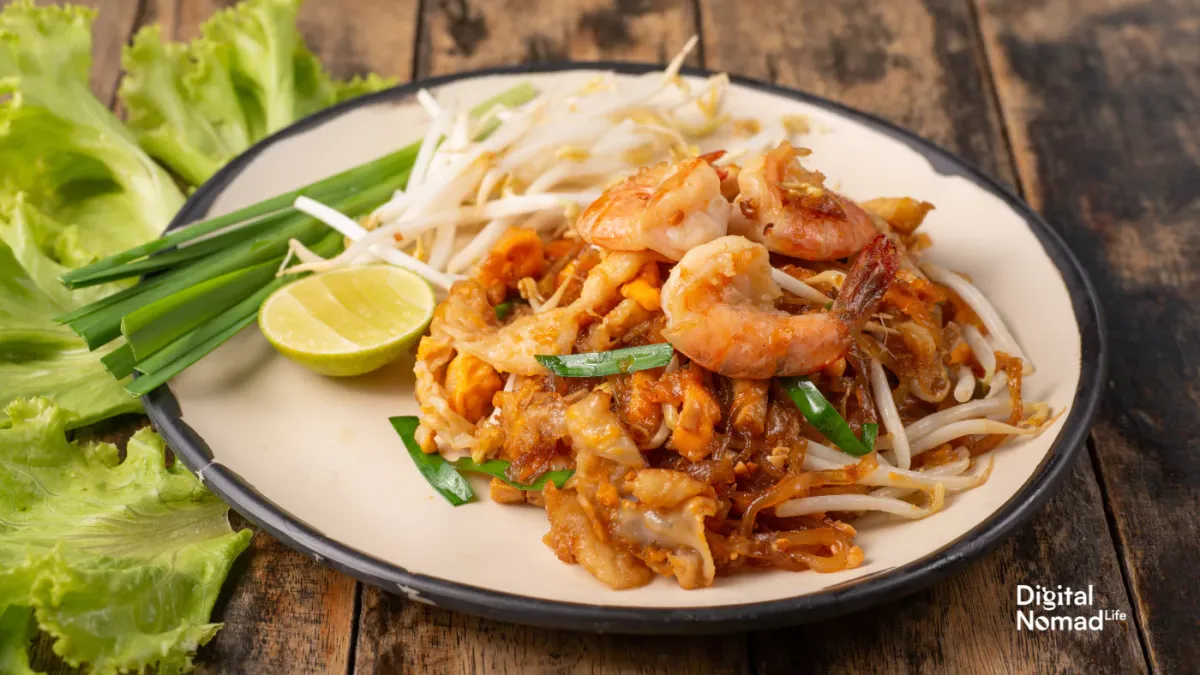
I often get questions like, 'What do you eat when you're in Thailand?' or 'Where do you find all that amazing food you have every day in Thailand?' So I thought I’d write a blog to walk you through the basics of Thai cuisine —what to enjoy and how to enjoy it.
If you're a foodie and interested in understanding the flavours of Thai cuisine, please read this blog to understand traditional ingredients and flavours in Thai food cuisine.
Let’s get started!
Popular Thai Foods and How to Eat Them
Thai cuisine is celebrated for its iconic dishes, many of which have gained international fame. Here are the must-try foods in Thailand:
1. Pad Thai (ผัดไทย)
Sweet, sour, and savory stir-fried rice noodle dish made with tamarind, egg, tofu or shrimp, and topped with crushed peanuts and lime.
📍 Region: Central (Bangkok)
🧂 Flavor: Sweet, sour, salty, umami
🥢 Ingredients:
- Rice noodles
- Tamarind paste
- Fish sauce, palm sugar
- Egg, tofu, shrimp or chicken
- Bean sprouts, peanuts, lime
🍽 How to Eat:
Squeeze lime, mix in crushed peanuts and chili flakes, eat with chopsticks or fork + spoon combo (not knife!).
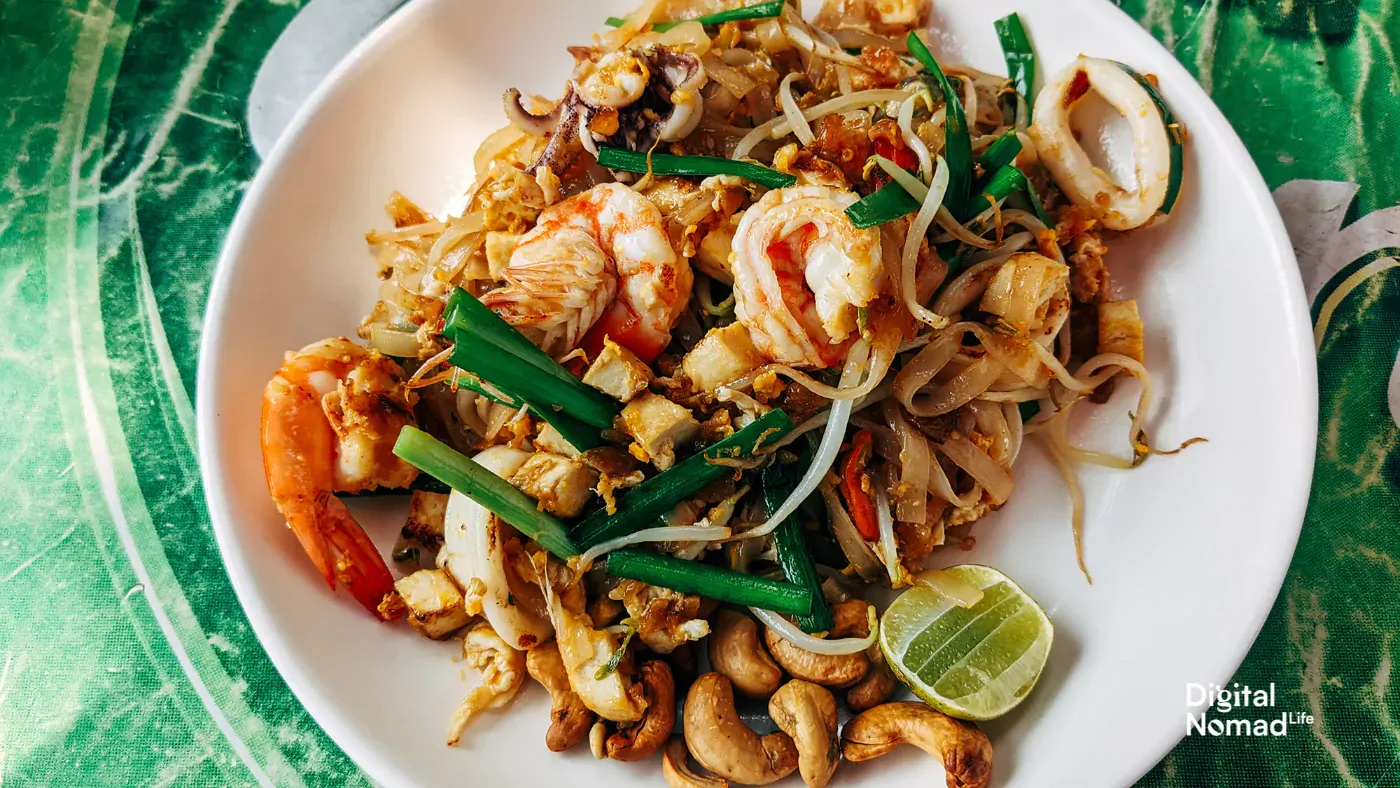
2. Tom Yum Goong (ต้มยำกุ้ง)
Hot and sour soup made with prawns, lemongrass, kaffir lime leaves, galangal, and chili paste, known for its bold, aromatic flavors.
📍 Region: Central
🧂 Flavor: Spicy, sour, aromatic
🥢 Ingredients:
- Prawns
- Lemongrass, galangal, kaffir lime leaves
- Chili paste, lime juice, fish sauce
- Mushrooms
🍽 How to Eat:
Served hot — spoon the broth and eat prawns and mushrooms with rice on the side.

3. Som Tum aka papaya salad (ส้มตำ)
Spicy green papaya salad pounded with garlic, chilies, lime, fish sauce, and palm sugar, often served with sticky rice and grilled meats.
📍 Region: Northeastern (Isaan)
🧂 Flavor: Spicy, sour, salty
🥢 Ingredients:
- Shredded green papaya
- Tomatoes, long beans
- Lime juice, fish sauce, chili
- Garlic, palm sugar, peanuts
🍽 How to Eat:
Eat with sticky rice and grilled chicken (gai yang). Use your fingers for the rice — totally normal in Isaan!
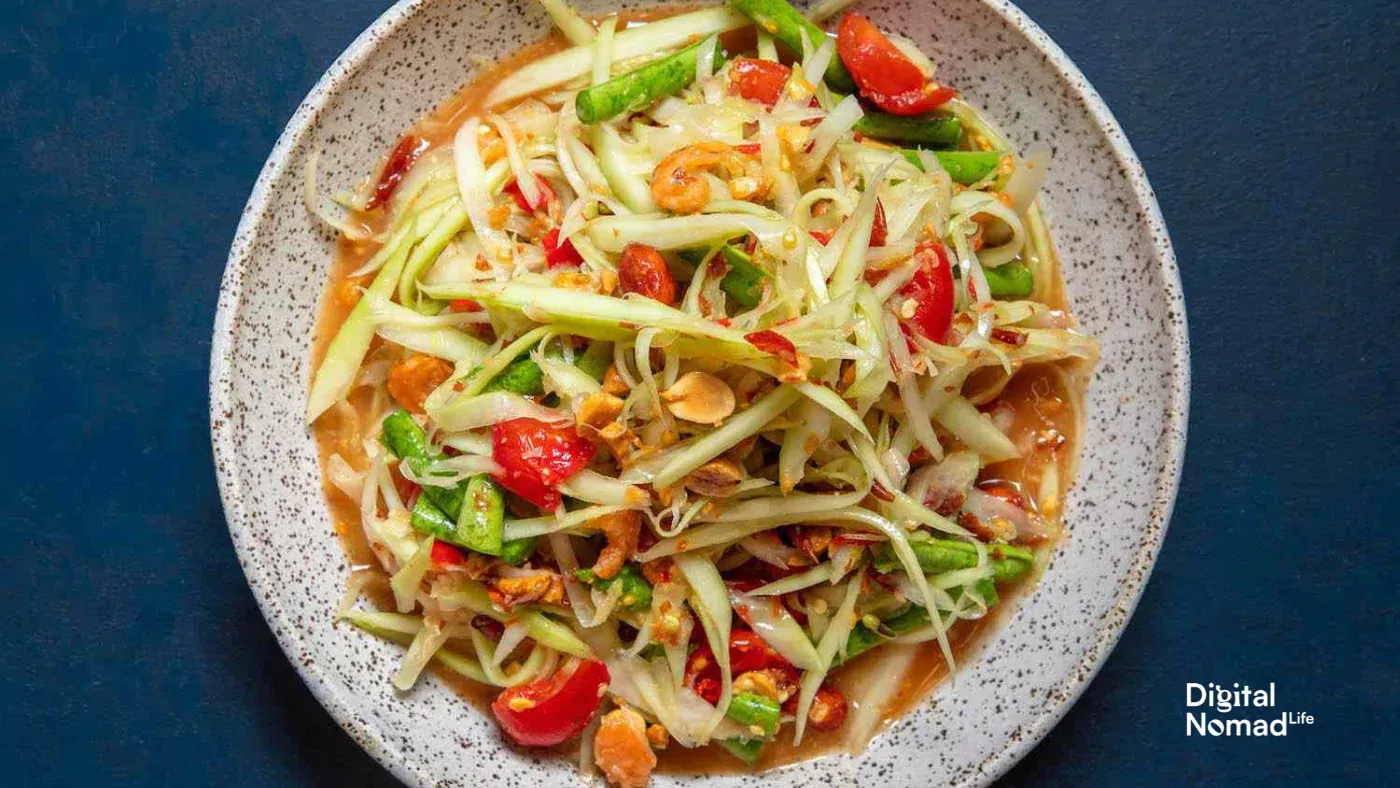
4. Khao Soi (ข้าวซอย)
Creamy and spicy northern Thai coconut curry noodle soup topped with crispy noodles, lime, and pickled mustard greens.
📍 Region: Northern (Chiang Mai)
🧂 Flavor: Creamy, spicy, fragrant
🥢 Ingredients:
- Egg noodles in curry coconut soup
- Chicken or beef
- Pickled mustard greens
- Shallots, lime, chili oil
🍽 How to Eat:
Mix crunchy and soft noodles before eating. Add a squeeze of lime and pickled greens for perfect balance.
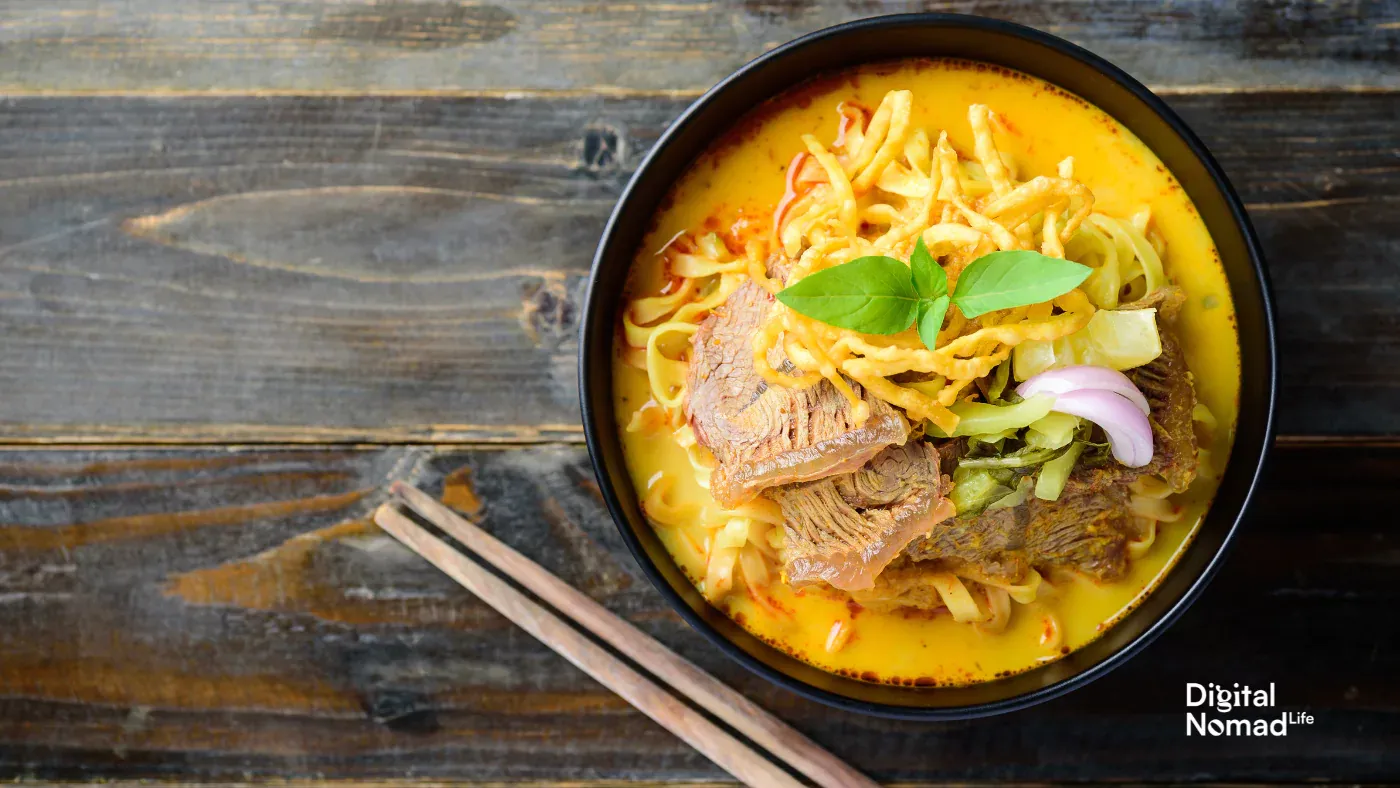
5. Massaman Curry (มัสมั่น)
Rich, mildly spicy curry with tender beef or chicken, potatoes, peanuts, and warming spices like cinnamon and nutmeg.
📍 Region: Southern (Muslim influence)
🧂 Flavor: Mild, sweet, nutty
🥢 Ingredients:
- Beef or chicken
- Potatoes, onions, peanuts
- Coconut milk
- Cinnamon, cloves, nutmeg, tamarind
🍽 How to Eat:
Spoon it over jasmine rice. Slow-cooked, so it melts in your mouth.
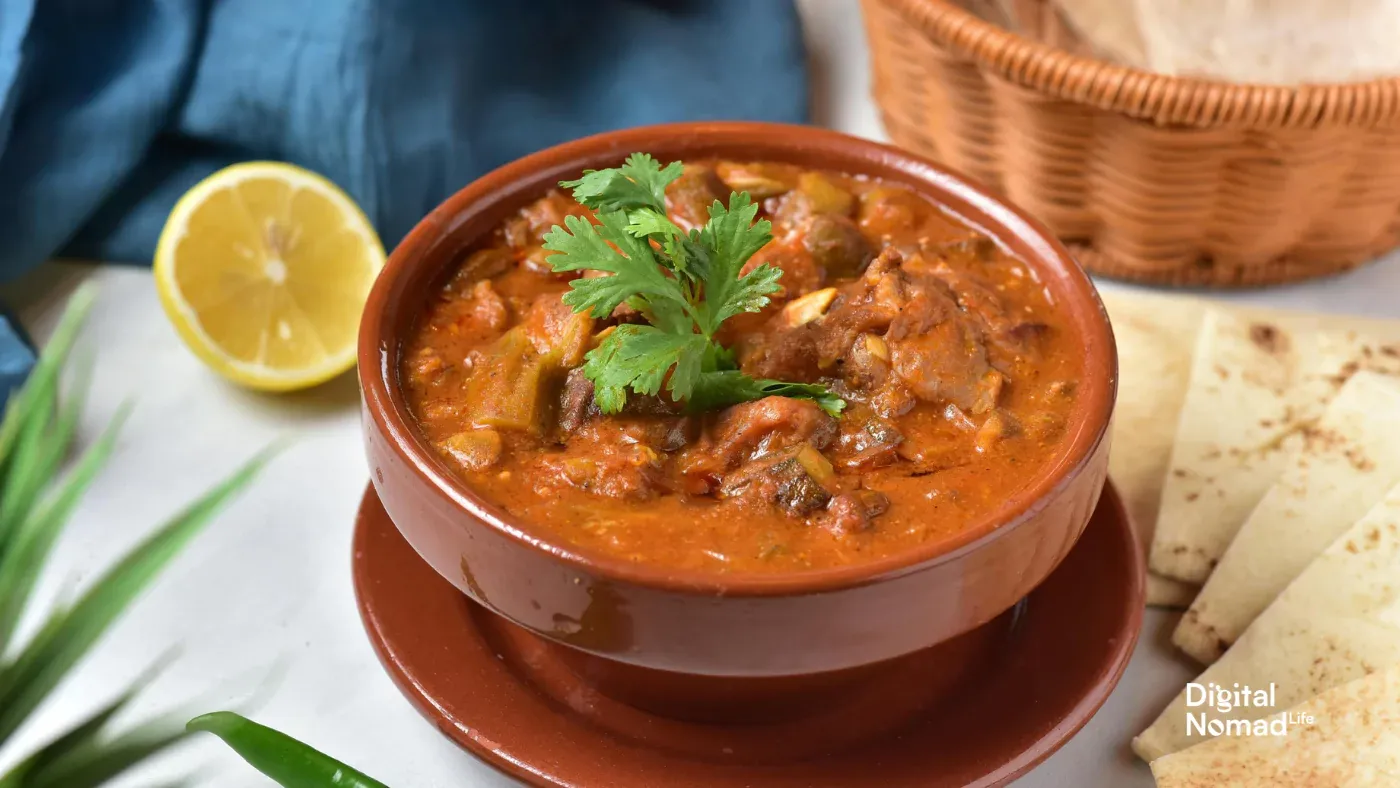
6. Pad Kra Pao (ผัดกะเพรา)
Spicy stir-fry made with holy basil, minced meat, garlic, and chilies, typically served over rice with a crispy fried egg on top.
📍 Region: Central
🧂 Flavor: Salty, spicy, garlicky
🥢 Ingredients:
- Minced pork or chicken
- Holy basil
- Garlic, chili
- Soy sauce, fish sauce
- Fried egg on top (optional but iconic!)
🍽 How to Eat:
Mix the runny egg yolk into the rice — locals often ask for “kai dao” (fried egg) on top.
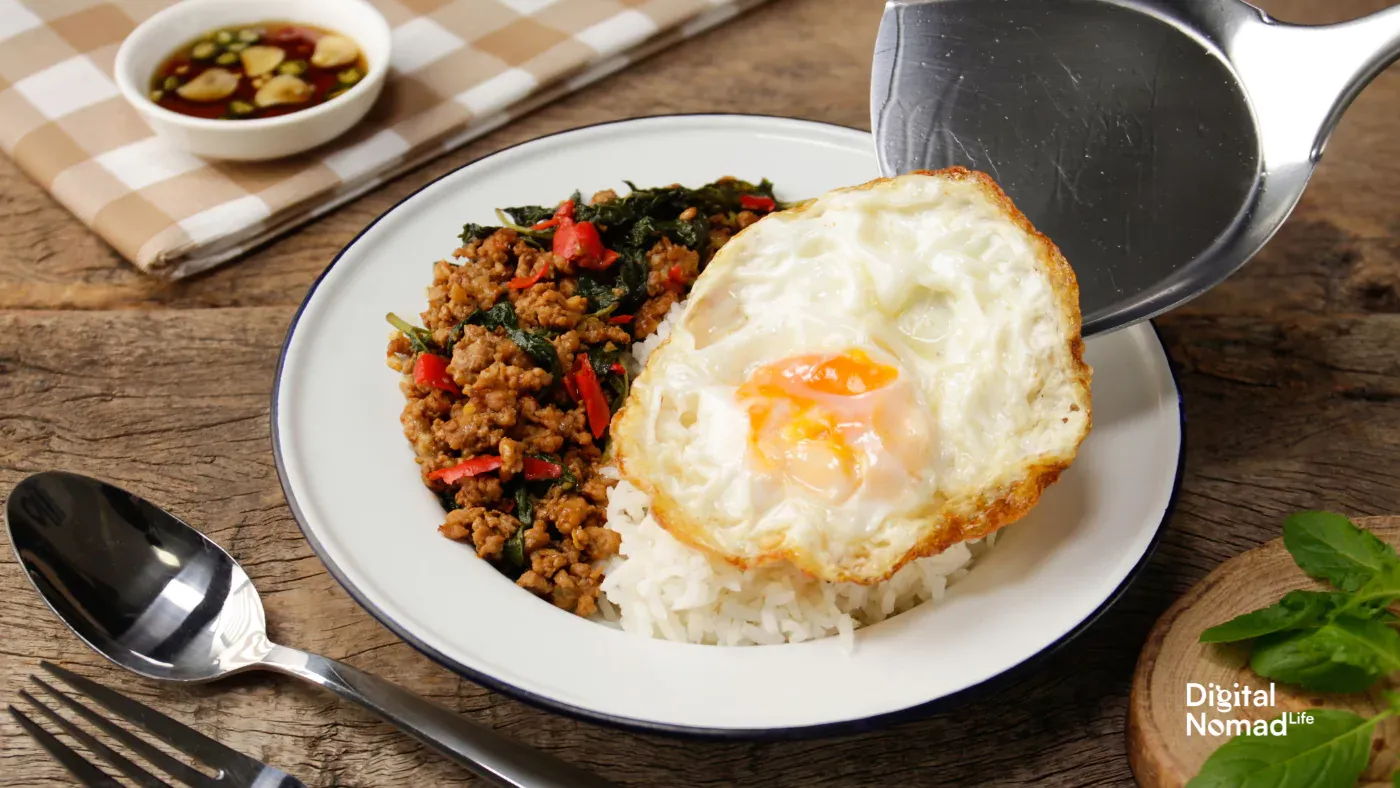
7. Gaeng Keow Wan (Green Curry - แกงเขียวหวาน)
Fragrant coconut-based curry with green chili paste, chicken or fish balls, Thai eggplant, and sweet basil.
📍 Region: Central
🧂 Flavor: Spicy, creamy, herbal
🥢 Ingredients:
- Chicken, eggplant
- Coconut milk
- Green curry paste (green chilies, basil, kaffir lime)
- Palm sugar, fish sauce
🍽 How to Eat:
Served with jasmine rice. Use spoon to scoop curry and rice together.
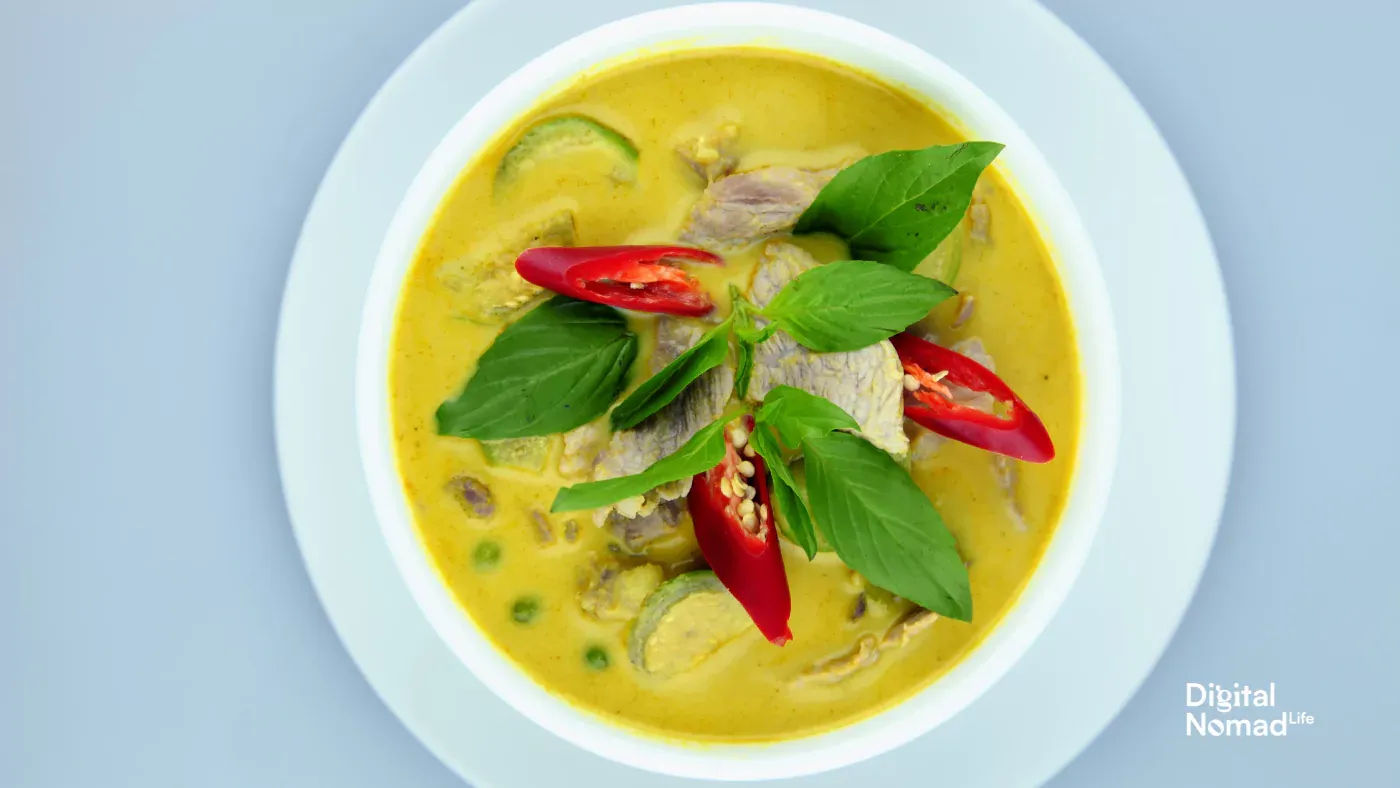
8. Laab (ลาบ)
Spicy and tangy minced meat salad from the Northeast, made with toasted rice powder, lime juice, fish sauce, and fresh herbs like mint.
📍 Region: Isaan (Northeast)
🧂 Flavor: Spicy, tangy, herby
🥢 Ingredients:
- Minced pork or chicken
- Toasted rice powder
- Fish sauce, lime juice, chili
- Mint, shallots
🍽 How to Eat:
Scoop with sticky rice or fresh cabbage leaves. Eaten with hands in rural areas.
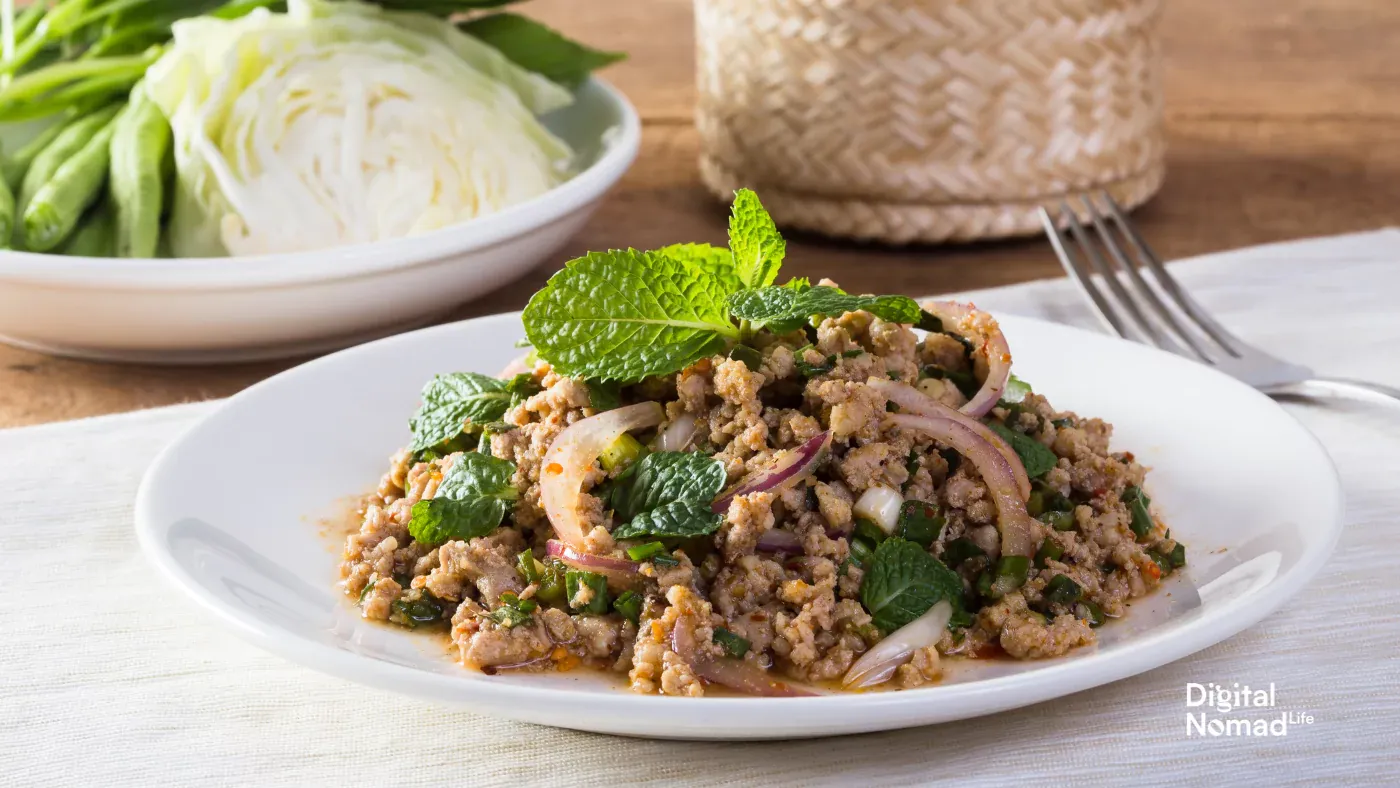
9. Gai Yang (ไก่ย่าง)
Marinated and grilled Thai-style chicken dish, often served with sticky rice, som tum, and a side of sweet chili dipping sauce.
📍 Region: Isaan (Northeast)
🧂 Flavor: Smoky, sweet, savory
🥢 Ingredients:
- Grilled chicken
- Marinated in garlic, cilantro root, soy sauce, fish sauce
- Served with sweet chili sauce
🍽 How to Eat:
Always eaten with som tum and sticky rice. Tear apart with your hands!
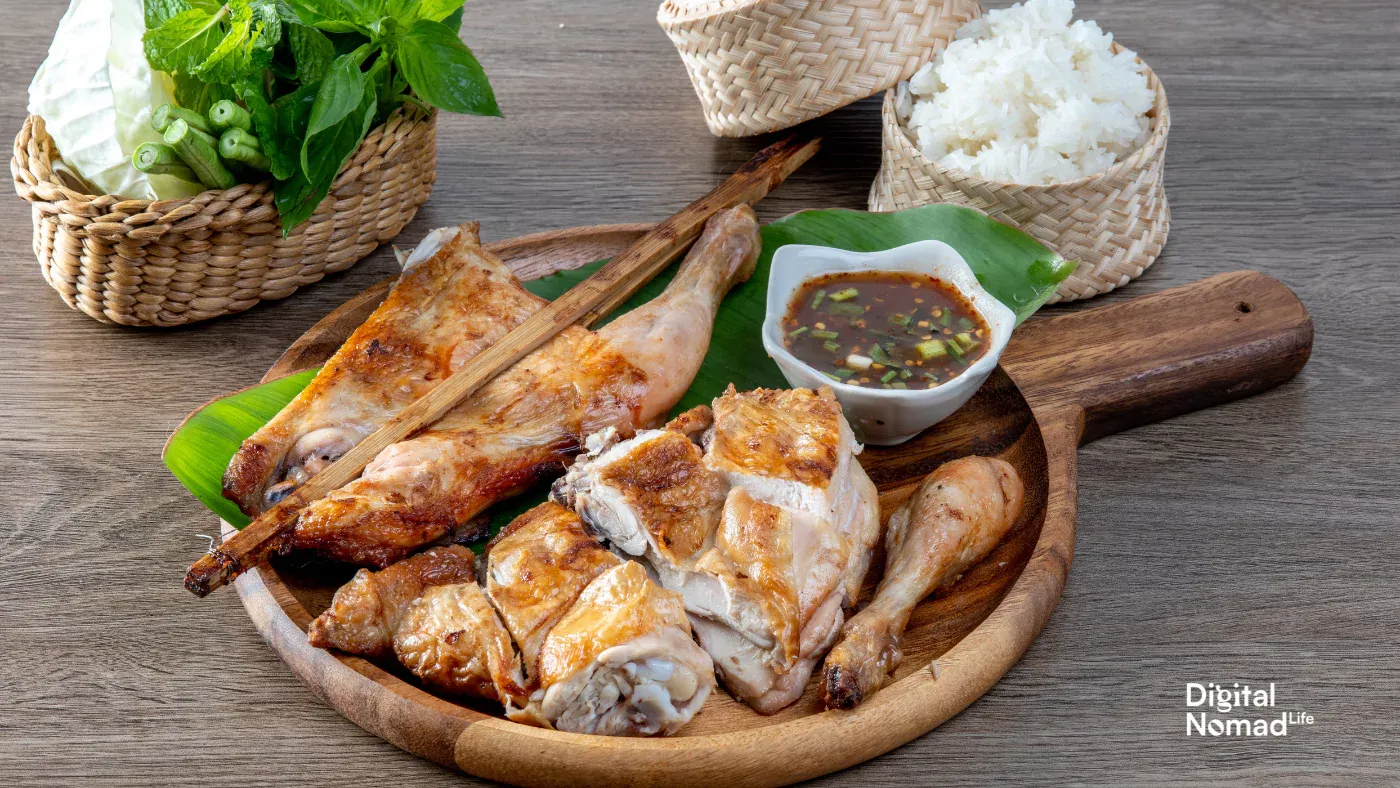
9. Red Curry with Chicken (แกงเผ็ดไก่)
Bold, aromatic red curry made with red chili paste, coconut milk, chicken, and Thai basil — spicy, fragrant, and deeply satisfying.
📍 Region: Central Thailand
🧂 Flavor: Spicy, creamy, slightly sweet
🥢 Ingredients:
- Chicken (or tofu/shrimp)
- Red curry paste (dried red chilies, lemongrass, garlic, galangal, kaffir lime)
- Coconut milk
- Bamboo shoots or bell peppers
- Fish sauce, palm sugar, Thai basil
🍽 How to Eat:
Spoon generously over hot jasmine rice and enjoy with a side of fresh vegetables or fried egg if available.
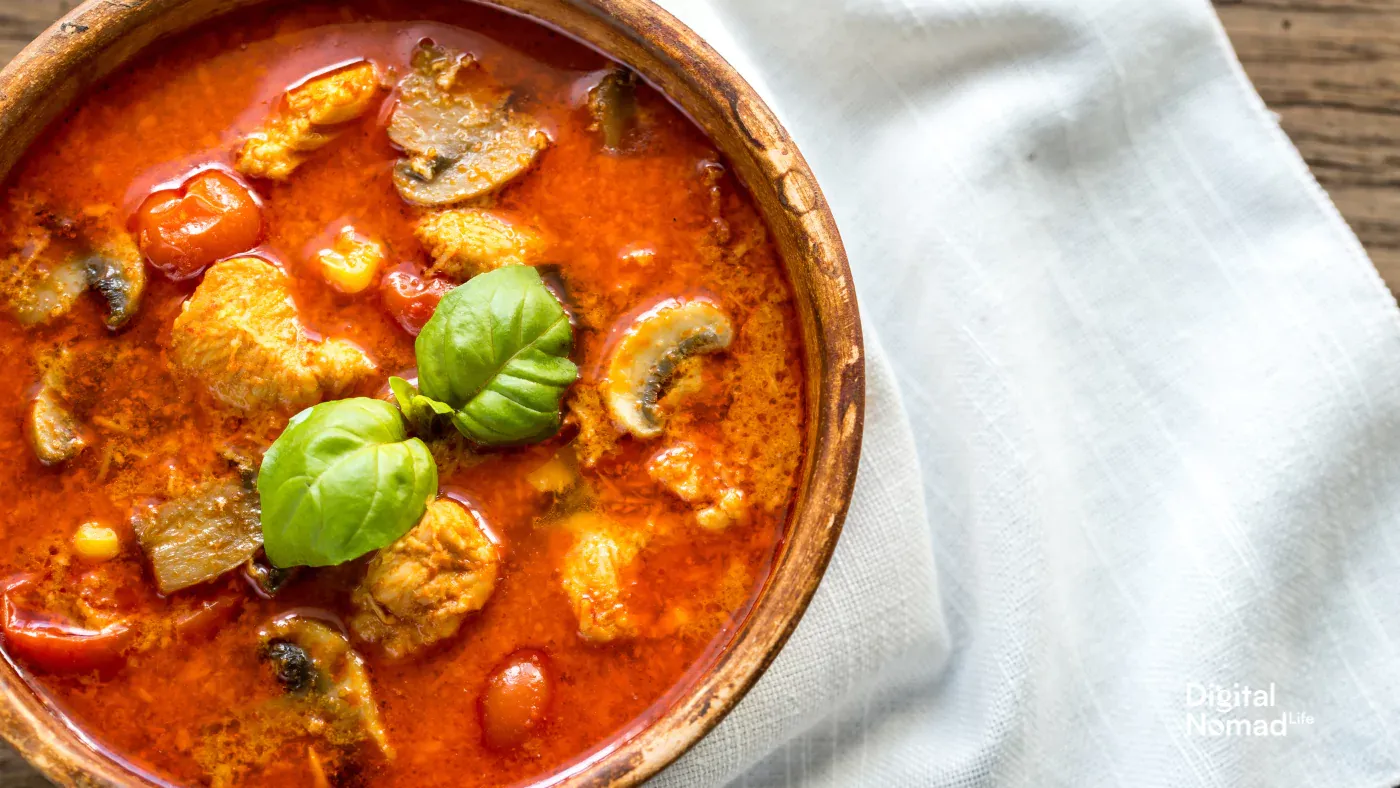
✨ Bonus Tips:
- Spice levels vary — if you're sensitive, say “mai phet” (not spicy) or “phet nit noi” (a little spicy).
- Thai people usually use spoon + fork (not chopsticks) for rice dishes.
Embracing the Foods of Thailand
If you want first hand experience of understanding Thai cuisine, I'd recommend starting with a cooking class. These classes are now one of the top-rated tourist activities, especially in Chiang Mai, Bangkok, and Koh Samui. I took one in Chiang Mai and absolutely loved it.
Ready to explore the best foods in Thailand? Share your favorite dishes and experiences in the comments, and start planning your next gastronomic journey through this incredible country!
❓Frequently Asked Questions
1. What are the most popular Thai dishes to try for first-time visitors?
Some of the most beloved Thai dishes include Pad Thai, Tom Yum Goong, Som Tum, Green Curry, and Massaman Curry — each offering a unique flavor experience.
2. Is Thai food always spicy? Can I ask for less heat?
Not all Thai dishes are spicy, and yes — you can ask for milder versions. Use phrases like “mai phet” (not spicy) or “phet nit noi” (a little spicy) when ordering.
3. What is the best way to experience authentic Thai food?
Visit local markets and street food stalls, and consider joining a cooking class — especially in Chiang Mai, Bangkok, or Koh Samui — to learn hands-on.
4. Are there vegetarian or vegan options in Thai cuisine?
Yes! Many dishes like Pad Thai, Green Curry, and Laab can be made vegetarian or vegan — just ask for tofu and check that the sauces don’t contain shrimp paste or fish sauce.
5. Where can I find the best regional dishes in Thailand?
While regional dishes are available across Thailand, the best versions are found in their places of origin — like Khao Soi in Chiang Mai or Som Tum in Isaan.




Comments ()